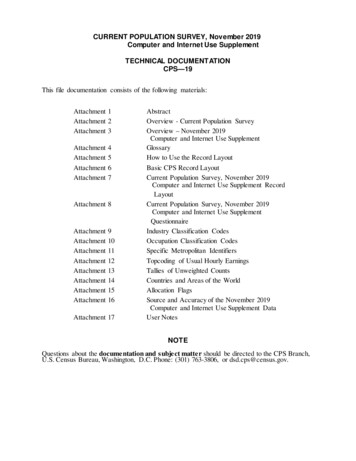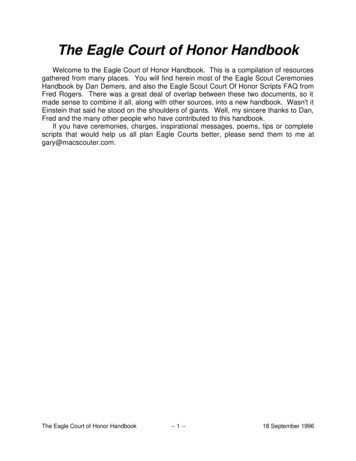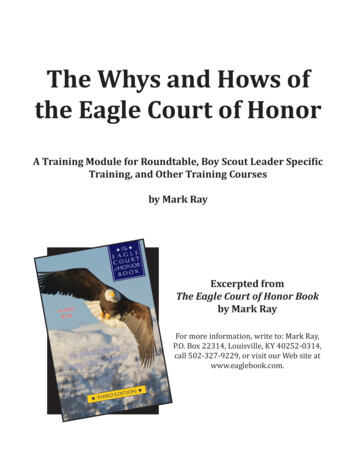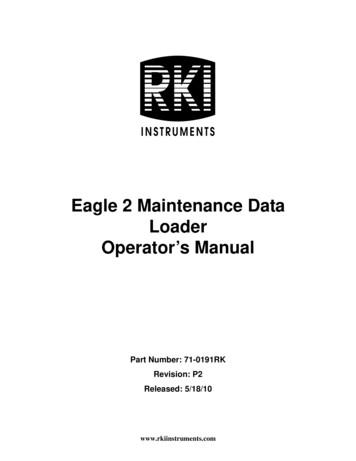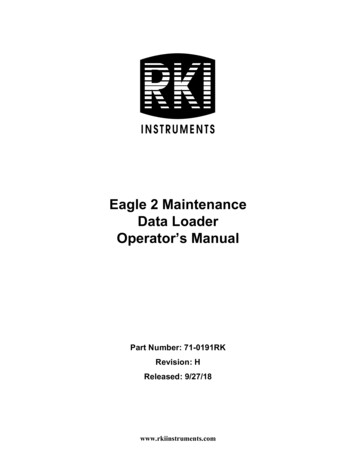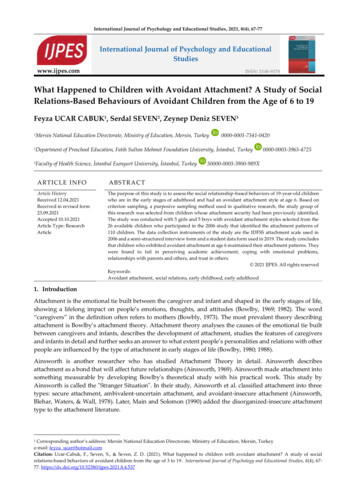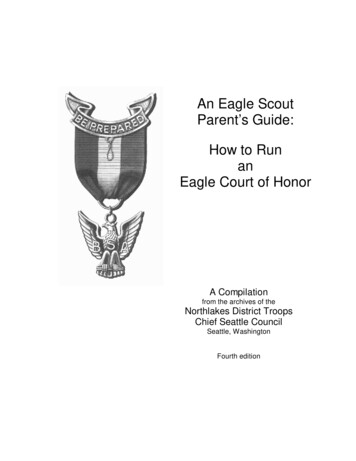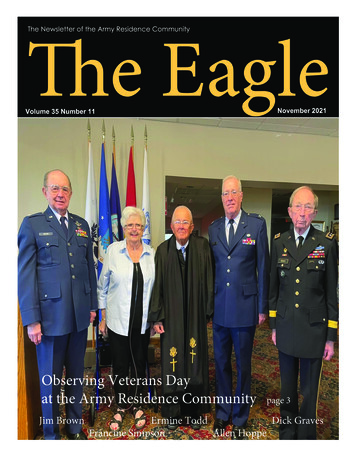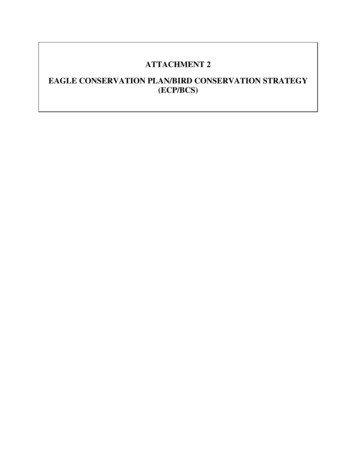
Transcription
ATTACHMENT 2EAGLE CONSERVATION PLAN/BIRD CONSERVATION STRATEGY(ECP/BCS)
Mohave County Wind FarmEagle Conservation Plan andBird Conservation StrategyPrepared forBP Wind Energy North America Inc.Prepared by1750 SW Harbor Way, Suite 400Portland, OR 97201December 2012
Mohave County Wind FarmEagle Conservation Plan and Bird Conservation StrategyTABLE OF CONTENTS1INTRODUCTION.11.1 Background Information.11.2 Project Description .51.3 Environmental Setting.91.4 Regulatory Framework .91.4.1 Migratory Bird Treaty Act.91.4.2 Bald and Golden Eagle Protection Act .101.4.3 BLM Instruction Memorandum No. 2010-156 .101.4.4 National Environmental Policy Act.101.4.5 Memoranda of Understanding between BLM and AZGFD.111.4.6 Arizona State Statutes .112MONITORING AND SURVEYING TO DATE .112.1 Bird Use Survey Methods .112.1.1 Golden Eagle Results .152.1.2 Non-eagle Bird Species Results.162.1.3 Sensitive Species.172.2 Songbird Migration Surveys.172.3 Golden Eagle Nest Surveys.202.3.1 2011 Golden Eagle Nest Survey Results .242.3.2 2011 Raptor Nests .242.3.3 2012 Golden Eagle Nest Survey Results .243RISK ASSESSMENT .283.1 Collision.283.1.1 Golden Eagles .283.1.2 California Condor .383.1.3 Other Non-eagle Bird Species.383.2 Electrocution.473.3 Disturbance/Displacement .473.3.1 Golden Eagles .473.3.2 Non-eagle Bird Species .483.4 Habitat Fragmentation .494PROJECT PLANNING AND DESIGN MEASURES.495CONSTRUCTION PHASE MEASURES.546OPERATIONAL PHASE MEASURES .567POST-CONSTRUCTION FATALITY MONITORING .587.1 Initial Post-construction Fatality Monitoring.597.2 Long-term Fatality Monitoring .597.3 Responsive Monitoring .607.4 Eagle Behavioral Monitoring .607.5 Wildlife Incident Monitoring System .617.5.1 Training.617.5.2 Reporting .617.6 Standardized Post-construction Fatality Monitoring .617.6.1 Technical Approach .617.6.2 Standardized Carcass Searches – Non-eagle bird species .627.6.3 Standardized Carcass Searches – Eagles .647.6.4 Carcass Persistence Trials.65iDecember 2012
Mohave County Wind Farm7.6.57.6.6Eagle Conservation Plan and Bird Conservation StrategySearcher Efficiency Trials.67Fatality Rate Estimation .678MITIGATION AND ADAPTIVE MANAGEMENT .698.1 Identification of Compensatory Mitigation Approach .698.1.1 Evidence for Eagle Fatalities Due to Vehicle Collisions .698.1.2 Existing Information on Vehicle and Wildlife Collisions.718.2 Overview of Carcass Search/Removal as Compensatory Mitigation.738.3 Implementing Mechanisms .748.4 Bottom-up and Top-down Approaches for Mitigation .748.5 Bottom-up Approach for Mitigation.748.5.1 Step 1: Determine Where Mitigation Efforts Should Be Targeted WithinArizona .758.5.2 Step 2: Evaluate the Annual Rate of Carcass Occurrence .788.5.3 Step 3: Calculate the Number of Carcasses Available for Eagles per 100miles of road.798.5.4 Step 4: Calculate the Percentage of Carcasses Used by Golden Eagles .798.5.5 Step 5: Calculate the Number of Eagles Per Carcass .808.5.6 Step 6: Calculate the Number of Eagles Using Carcasses .818.5.7 Step 7: Evaluate the Percentage of Eagles Involved in a Vehicle CollisionWhile Feeding on Carcasses .818.5.8 Step 8: Calculate the Number of Vehicle-Eagle Collisions per Year in theAbsence of Carcass Search/Removal .818.5.9 Step 9: How Many Miles of Roads Will Have Carcass Search/Removal.828.6 Top-down Approach for Mitigation .828.6.1 Step 1: Estimate the Number of Golden Eagles Killed by Vehicle Collisionin Arizona .838.6.2 Step 2: Estimate the Total Mileage of Roads within Habitat Suitable forGolden Eagles .868.6.3 Step 3: Calculate the Number of Road Miles for Carcass Search/Removalto Offset the Loss of One Golden Eagle.878.7 Comparison of the Bottom-Up and Top-Down Approaches.878.8 Implementation of the Roadside Carcass Search/Removal Program.898.9 Operational Mitigation and Adaptive Management for Eagles.918.9.1 Adaptive Management of Curtailment Program.928.10 Mitigation and Adaptive Management for Non-eagle Bird Species.958.10.1 Thresholds .958.10.2 Timing of Trigger Evaluation .968.10.3 Compensatory Mitigation.978.11 Responsive Monitoring .1009REPORTING.10010DECOMMISSIONING .10111LITERATURE CITED .102iiDecember 2012
Mohave County Wind FarmEagle Conservation Plan and Bird Conservation StrategyLIST OF TABLESTable 1.Chronology of Resource Agency Contact for BP Wind Energy’s ProposedMohave County Wind Farm Eagle Conservation Plan and Avian ConservationStrategy.2Table 2.Summary of Golden Eagle Observations within Project area Boundary atMohave County Wind Farm During 2012 Point Count Surveys 1 .15Table 3.Summary of Individuals of Sensitive Species Detected by Survey Type IncludingSize Classification and Status .18Table 4.2011 Golden Eagle Nest Data Collected by WEST for the Mohave County WindFarm and 10-mile Survey Buffer (Thompson 2011) .25Table 5.2012 Golden Eagle Nest Data for the Mohave County Wind Farm and 10-mileSurvey Buffer (Tetra Tech 2012) .26Table 6.Variables and Constants Used in the Calculation of Potential Eagle Fatalities forthe Mohave County Wind Farm. .30Table 7a. Estimates of Mean Bird Fatalities per Turbine and per Megawatt at WindFacilities Nationally in the U.S. .41Table 7b. Estimates of Mean Bird Fatalities per Turbine and per Megawatt at WindFacilities in Desert Regions of the Western U.S. .45Table 8.Post-construction Monitoring Frequency .60Table 9.Comparison of Non-eagle and Eagle Post-Construction Fatality SamplingDesign.62Known Causes of Golden Eagle Fatalities in Arizona from AZGFD .70Table 10.Table 11.Table 12.Golden Eagle Vehicle Collision Data from the Reports, Databases, and Peerreviewed Literature.70Golden Eagle Fatalities from Rehabilitation Centers.71Table 13.Summary of Wildlife-vehicle Collision Rates in the U.S. .72Table 14.Statewide Crashes in Arizona (ADOT 2011).73Table 15.Summary of Steps Taken to Calculate the Number of Golden Eagles Saved perMile of Road Where Carcasses are Removed.75Table 16.Eagle Experts Contacted and Their Associated Expertise, Affiliation, and Yearsof Experience .80Table 17.Comparison of Inputs and Adaptive Management Between Bottom-up and Topdown approaches .88Table 18.Mitigation Schedule for Non-eagle Birds.98Table 19.Example Timeline for Reporting and Eagle Take Permitting.101iiiDecember 2012
Mohave County Wind FarmEagle Conservation Plan and Bird Conservation StrategyLIST OF FIGURESFigure 1.Proposed Project Layout, EIS Alternative A With Turbines Removed Due to theAddition of a 1.25-mile No-Build Buffer Around the Squaw Peak Breeding Areaand a Curtailment Zone. .7Figure 2.Eagle Flight Paths and Point Count Locations in 2007/2008 and 2010/2011 .12Figure 3.Eagle Flight Paths and Eagle Point Count Locations in 2012 .14Figure 4.2011 Golden Eagle Breeding Area Locations* and Status.21Figure 5.2012 Golden Eagle Breeding Area Locations* and Status.22Figure 6.Palmer Drought Severity Index for Northwest Arizona from January 2000 to April2012*.32Figure 7.Mean Use by Golden Eagles (Eagle Use/20 min; Pre-construction), TotalGolden Eagle Fatalities, and Total Golden Eagle Fatalities/MW (Post construction) at 15 Wind Energy Projects in the Western U.S. Compared toMean Use at Mohave County Wind Farm (Value Circled in Red). .34Figure 8.Slope (in Degrees) of Land within the Mohave County Wind Farm.36Figure 9.Aspect of Land Surface within the Mohave County Wind Farm .37Figure 10. Permanent Met Tower Design (Photo from Idaho Falls, Idaho) .53Figure 11. Preliminary Roadways Identified for the Implementation of a CarcassSearch/removal Program Using a Kernel Analysis to Define Golden EagleHabitat and SERI Data on Large Mammal Population Densities (Tribal Landsand the Phoenix Metro Area Were Not Reported or Included in Analyses). .77Figure 12. Adaptive Management of Golden Eagle Fatalities at the Mohave County WindFarm.90Figure 13 Flowchart of Example Non-eagle Bird Mitigation Over First Five Years of ProjectOperation .99LIST OF APPENDICESAppendix A Table of All Avian Species DetectedAppendix B Wildlife Incident Reporting System ProtocolAppendix C Wildlife Incident Reporting FormivDecember 2012
Mohave County Wind FarmEagle Conservation Plan and Bird Conservation StrategyThis page is intentionally left blankvDecember 2012
Mohave County Wind FarmEagle Conservation Plan and Bird Conservation StrategyACRONYMS AND ABBREVIATIONSAERIAmerican Eagle Research InstituteAPLICAvian Power Line Interaction CommitteeARSArizona Revised StatutesAZGFDArizona Game and Fish DepartmentBCSBird Conservation StrategyBGEPABald and Golden Eagle Protection ActBLMBureau of Land ManagementReclamationBureau of ReclamationBP Wind EnergyBP Wind Energy North America Inc.CIconfidence intervalcmcentimeterCRPConservation Reserve ProgramDVCdeer-vehicle collisionECPEagle Conservation PlanEISEnvironmental Impact Statement Fdegrees FahrenheitGPSGlobal Positioning SystemIMInstruction Memorandumkmkilometerkm2square kilometerMBTAMigratory Bird Treaty National Environmental Policy ActO&MOperations and MaintenancePDSIPalmer Drought Severity IndexProjectMohave County Wind FarmProject areaarea within the Project’s proposed right-of-way boundariesRODRecord of DecisionRSArotor swept areasecsecondSERISpecies of Economic and Recreational ImportanceviDecember 2012
Mohave County Wind FarmEagle Conservation Plan and Bird Conservation StrategyUSGSU.S. Geological SurveyUSFWSU.S. Fish and Wildlife ServiceUVCungulate-vehicle collisionWESTWestern EcoSystems Technology, Inc.WesternWestern Area Power AdministrationWIRSWildlife Incident Reporting SystemviiDecember 2012
Mohave County Wind Farm1INTRODUCTION1.1Background InformationEagle Conservation Plan and Bird Conservation StrategyBP Wind Energy North America Inc. (BP Wind Energy), a wholly owned, indirect subsidiary ofBP p.l.c., a publicly traded company, or an affiliate thereof, is proposing to develop, own, andoperate the Mohave County Wind Farm (Project) in Mohave County, northwestern Arizona, onfederal lands managed by the Bureau of Land Management (BLM) and the Bureau ofReclamation (Reclamation). BP Wind Energy has applied to interconnect the proposed Projectwith either the Western Area Power Administration’s (Western) Liberty-Mead transmission lineor the Mead-Phoenix transmission line (of which Western is one of several co-owners) for up to500 megawatt (MW). The proposed Project would interconnect through a new switchyard to beconstructed within the Project area. Currently, an Environmental Impact Statement (EIS) isbeing developed for the Project to meet the requirements of the National Environmental PolicyAct (NEPA) of 1969. The NEPA process was initiated in 2006. BLM is the lead agency for theProject and released the Draft EIS for public comment from April 27, 2012 to June 18, 2012.The Final EIS is scheduled to be released to the public starting in December 2012.BP Wind Energy contracted Tetra Tech to create this Eagle Conservation Plan (ECP) and BirdConservation Strategy (BCS) in order to meet the requirements of BLM InstructionalMemorandum (IM) 2010-156, which provides direction for compliance under the Migratory BirdTreaty Act (MBTA; see Section 1.4.1, Regulatory Framework) and the Bald and Golden EagleProtection Act (BGEPA; see Section 1.4.2, Regulatory Framework). The purpose of thisdocument is to provide sufficient information to allow BLM to comply with BLM IM 2010-156.The IM states that the U.S. Fish and Wildlife Service (USFWS) must issue a letter ofconcurrence that addresses the adequacy of an Avian Protection Plan (APP) prior to BLMsigning a Record of Decision (ROD) for BGEPA and NEPA compliance. During the evolution ofthis process, USFWS has changed their preferred terminology from an APP to an ECP andBCS, as outlined in the Final Land-based Wind Energy Guidelines (USFWS 2012b). At the timewhen the IM was issued, USFWS had the authority to issues permits (USFWS 2009), but didnot have implementing guidelines that were subsequently released in the 2011 Draft ECPGuidance (USFWS 2011a). The USFWS views the process as described in the IM as one ofissuing a letter of acknowledgement instead of approval. The USFWS and BLM have agreedthat consideration of the ECP/BCS as the basis for issuing the letter of acknowledgement willsatisfy the IM requirement.This version of the document will not be the mechanism for permit issuance because BP WindEnergy and USFWS will continue to confer on the content of the ECP as BP Wind Energyprepares their formal application for a take permit. After submittal of the formal eagle take permitapplication, the USFWS has indicated they will complete their own NEPA analysis to considerissuance of a permit using the most current version of the ECP. This ECP/BCS is beingsubmitted so that BLM can meet their NEPA requirement in order to issue a ROD for theProject.This ECP/BCS summarizes the environmental conditions at the Project, avian studies that havebeen conducted and their results, an assessment of potential impacts to eagles and non-eaglebird species, avoidance and minimization elements, and compensatory mitigation for1December 2012
Mohave County Wind FarmEagle Conservation Plan and Bird Conservation Strategyunavoidable impacts of the Project. BP Wind Energy has worked closely with USFWS, theArizona Game and Fish Department (AZGFD), BLM, and Reclamation to develop the ECP/BCS(Table 1).Table 1.Chronology of Resource Agency Contact for BP Wind Energy’s Proposed MohaveCounty Wind Farm Eagle Conservation Plan and Avian Conservation StrategyDatePurposeAgency meeting at Kingman FieldOffice of BLM that partially focusedon wildlife surveys.AttendeesBLM (J. Cook, R. Sanchez, D. McClure, J.Neckels), BP Wind Energy (L. Mazer, B.Gibson)June 2008Agency meeting to discuss surveyresults and proposed future surveys.BLM, AZGFD, and BP Wind EnergyJuly 11, 2008Written submittal of 2007-2008survey results and proposed surveysfor 2008-2009 year.BLM (J. Priest, R. Peck), AZGFD (G. Ritter,B. Cary), USFWS (S. Spangel, B. Smith)August 13, 2008Written comments on proposedwildlife surveysAZGFD (G. Ritter, L. Canaca, T. Buhr)August 25, 2008Email survey results from WesternEcoSystems Technology, Inc.(WEST) submitted to BLM.WEST (R. Good), BLM (J. Priest, R. Peck,J. Cook), BP Wind Energy (B. Gibson, L.Mazer)May 4, 2009Email submittal of 2008-2009 surveyresults and proposed 2009-2010survey methods.BLM (J. Crockford, J. Neckels, A. Wilhelm,J. Stroud)July 19, 2011Conference call and webinar withWEST presenting results of 2011eagle nest surveys; and discussionof ECP/BCS process with connectionto NEPA compliance and EISprocess already underway. Draftmeeting minutes were circulated forinput and then finalized later andrecirculated.AZGFD (K. Jacobson, G. Ritter),Reclamation (M. Maynard), Western (B.Werner), BLM (K. Grove, A. Wilhelm),USFWS (B. Wooldridge, C. O’Meilia),WEST (J. Thompson), BP Wind Energy (K.Wells, T. Eagleston, D. Quick, D. Runyan)August 10, 2011Conference call to discuss resourceagencies preliminary impressions ofbaseline wildlife study reports andeagle nest survey report; discussresource agency support for EISimpact assessment; and discussECP/BCS process. Draft minutescirculated for input with final minutescirculated later. BP Wind Energyformally commits to preparing anECP/BCS.AZGFD (K. Jacobson), Western (B.Werner), BOR (M. Maynard), BLM (K.Grove, E. Arreola), USFWS (R. Murphy, B.Wooldridge, C. O’Meilia), WEST (J.Thompson), URS (J. Charpentier), BPWind Energy (K. Wells, D. Quick, T.Eagleston)September 19, 2011In person meeting to discusspreliminary impact assessment. Hardcopy of formal letter from USFWS toBP Wind Energy also provided inperson documenting low impact withmoderate uncertainty.USFWS (R. Murphy), BP Wind Energy (K.Wells)January 29, 20082December 2012
Mohave County Wind FarmTable 1.Eagle Conservation Plan and Bird Conservation StrategyChronology of Resource Agency Contact for BP Wind Energy’s ProposedMohave County Wind Farm Eagle Conservation Plan Avian ConservationStrategy (continued)DateOctober 5-9, 2011PurposeInformal discussions in person atRaptor Research Meeting aboutpotential mitigation approachesAttendeesUSFWS (R. Murphy, B. Millsap), TetraTech (L. Nagy, C. Farmer)October 13, 2011Conference call to discuss existinggolden eagle fatality data in Arizonaand get AZGFD feedback on mostviable eagle mitigation options.AZGFD (K. Jacobson, G. Ritter, D.Kephart, J. Driscoll), BP Wind Energy (K.Wells)October 26, 2011Conference call to discuss proposedeagle mitigation concepts.AZGFD (K. Jacobson), USFWS (R.Murphy, B. Wooldridge, B. Werner), TetraTech (L. Nagy, C. Farmer), BP WindEnergy (K. Wells)October 31, 2011Telephone call to USFWS Region 2Special Agent In Charge for LawEnforcement to ask about availabilityof eagle fatality and source data.USFWS (N. Chavez), BP Wind Energy (K.Wells)November 1-17, 2011Email and telephone interviews ofeagle experts regarding potentialcarcass mitigation and risk posed toeagles by road-killed carcasses.American Eagle Research Institute(D. Driscoll), Big Horn Environmental (T.Maetchle), Bloom Biological (P. Bloom), G.Doney, Montana State University (A.Harmata), Tetra Tech (C. Farmer, L. Nagy),USFS (T. Grubb), Wildlife ResearchInstitute (D. Bittner)November 9, 2011In-person and webinar meeting fromKingman BLM Field Office to providean update on ECP/BCS mitigationproposal and gather feedback onproposed 2012 Golden Eaglesurveys.BLM (K. Grove, A. Wilhelm), Western (M.Schriner), Reclamation (M. Maynard),AZGFD (K. Jacobson, D. Kephart), USFWS(R. Murphy, B. Werner, B. Wooldridge), andBP Wind Energy (K. Wells, B. Gibson, T.Eagleston)November 15-17, 2011In-person discussions during RaptorResearch Meetings on potentialmitigation options and riskassessment models.USFWS (R. Murphy, B. Millsap) and TetraTech (L. Nagy, C. Farmer)November 28, 2011Conference call to discuss eaglemanagement team suggestion ofconsidering out of state eaglemitigation. BP Wind Energy formallysubmits proposed eagle mitigationconceptual framework via email forUSFWS eagle management teamreview during telephone call onDecember 1, 2011.USFWS (R. Murphy) and BP Wind Energy(K. Wells)December 7, 2011Conference call to discuss USFWSeagle management team feedbackon proposed conceptual mitigationframework and seek clarification onspecifics of adaptive managementexpectedUSFWS (R. Murphy), BP Wind Energy (K.Wells), and Tetra Tech (L. Nagy and C.Farmer)3December 2012
Mohave County Wind FarmTable 1.Eagle Conservation Plan and Bird Conservation StrategyChronology of Resource Agency Contact for BP Wind Energy’s ProposedMohave County Wind Farm Eagle Conservation Plan and Avian ConservationStrategy (continued)DatePurposeAttendeesBLM (K. Grove, A. Wilhelm), Western (M.Schriner), Reclamation (M. Maynard),AZGFD (K. Jacobson, D. Kephart,J. Driscoll ), USFWS (R. Murphy,B. Werner, B. Wooldridge), and BP WindEnergy (K. Wells), Tetra Tech (L. Nagy, C.Farmer, and A. Oller)December 13, 2011Email from BP Wind Energy with theMohave Golden Eagle Survey Plandated 121311 to get feedback on BPWind Energy’s planned golden eaglesurveys for 2012December 15, 2011Conference call to discuss proposed2012 Golden Eagle Survey PlanAZGFD (K. Jacobson), USFWS(B. Werner), BP Wind Energy (K. Wells),Tetra Tech (L. Nagy, C. Farmer, and A.Oller)Provided copy of the Mohave CountyWind Farm Draft Eagle ConservationPlan (Mohave draft ECP 1-31 12.doc) to agencies for review andcomments.AZGFD (K. Jacobson, G. Ritter, D. Kephart,J. Driscoll, J. Kraft, D. Grandmaison),USFWS (B. Werner, R. Murphy, B.Woodridge), BLM (K. Grove, A. Wilhelm, E.Arreola, J. Neckels), Reclamation (M.Maynard), Western (M. Schriner, L.Hughes), BP Wind Energy (K. Wells, D.Runyan), Tetra Tech (L. Nagy), MorganLewis (D. Quick), and URS (B. Defend)Conference call to gather commentson Mohave Wind Farm Project EagleConservation Plan.AZGFD (K. Jacobson, G. Ritter, D.Kephart, J. Driscoll, J. Kraft, D.Grandmaison), USFWS (B. Werner, R.Murphy), BLM (K. Grove), BP Wind Energy(K. Wells, D. Runyan, T. Eagleston, M.Rigo, K. Pitney), Tetra Tech (L. Nagy,C. Farmer, and A. Oller), Morgan Lewis (D.Quick)April 17, 2012Conference call to discuss carcasssearch/removal mitigation location.AZGFD (J. Kraft, D. Grandmaison, D.Kephart, J. Driscoll, M. Ingradli) USFWS(B. Werner), BLM (K. Grove, E. Arreola),BP Wind Energy (D. Runyon, D. Gonzales,K. Wells), Tetra Tech (L. Nagy, A. Oller, C.Farmer), URS (J. Charpentier)April 26, 2012Conference call with USFWS todiscuss AZGFD eagle mitigationprotocol.USFWS (R. Murphy, B. Warner), BP WindEnergy (K. Wells), Tetra Tech (L. Nagy, C.Farmer)Conference call to discuss AZGFDCarcass Removal Plan protocol.AZGFD (T. Jacobson, G. Ritter, D.Grandmaison), USFWS (B. Werner), BPWind Energy (K. Wells), Tetra Tech (L.Nagy, C. Farmer, J. Garvin), URS, (J.Charpentier)Conference call to discuss AZGFDCarcass Removal Plan protocol.USFWS (B. Werner), BP Wind Energy (K.Wells, D. Gonzalez), Tetra Tech (L. Nagy,C. Farmer, J. Garvin, A. Oller), BLM (K.Grove, E. Arreola), Reclamation (M.Maynard), NPS (J. Holland, M. Boyles, A.Howard), Morgan Lewis (D. Quick), AZGFD(D. Kephart, G. Ritter, T. Jacobson, R.Schweinsburg, M. Piorkowski)February 2, 2012February 21, 2012May 9, 2012June 7, 20124December 2012
Mohave County Wind FarmTable 1.Eagle Conservation Plan and Bird Conservation StrategyChronology of Resource Agency Contact for BP Wind Energy’s ProposedMohave County Wind Farm Eagle Conservation Plan and Avian ConservationStrategy (continued)DateJune 26, 2012PurposeConference call to discuss whichvariant of the carcasssearch/removal plan was closest tomeeting USFWS regulatory needs.AttendeesUSFWS (R. Murphy), BP Wind Energy (K.Wells), Tetra Tech (L. Nagy, C. Farmer)July 5, 2012Provided copy of the 2 draft of theMohave County Wind Farm DraftEagle Conservation Plan (BPMohave ECP-ACS 07052012.docx)to agencies for review andcomments.AZGFD (K. Jacobson, G. Ritter, D.Kephart, J. Kraft, D. Grandmaison),USFWS (B. Werner, R. Murphy, B.Woodridge, C. Omelia), BLM (K. Grove, A.Wihelm, E. Arreola, J. Neckels),Reclamation (M. Maynard, F. Streier), NPS(J. Holland, M. Boyles), Weste
Mohave County Wind Farm Eagle Conservation Plan and Bird Conservation Strategy . 1 INTRODUCTION . 1.1 Background Information . BP Wind Energy North America Inc. (BP Wind Energy), a wholly owned, indirect subsidiary of BP p.l.c., a publicly traded company, or an affiliate thereof, is proposing to develop, own, and
